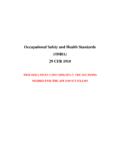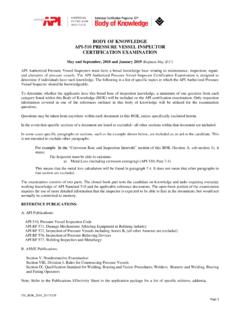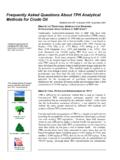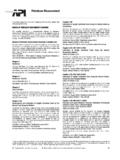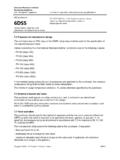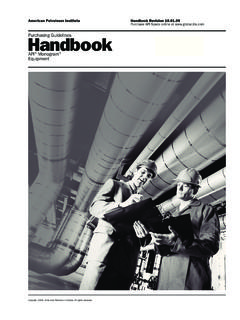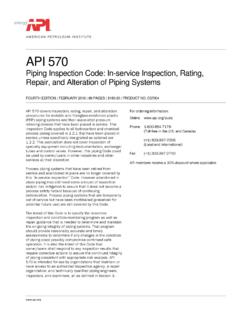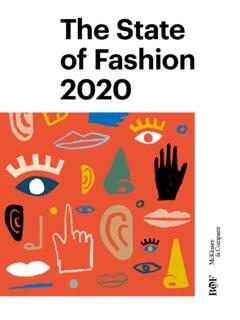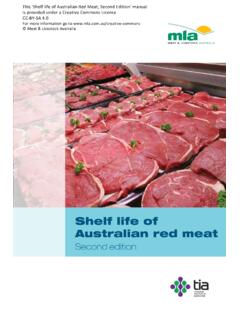Transcription of Estimating petroleum industry value chain (Scope 3 ...
1 Estimating petroleum industry value chain (Scope 3). greenhouse gas emissions Overview of methodologies Climate change THE GLOBAL OIL AND GAS. industry ASSOCIATION. FOR ENVIRONMENTAL AND. SOCIAL ISSUES. IPIECA/API 2016 All rights reserved. No part of this publication may be reproduced, stored in a retrieval system, or transmitted in any form or by any means, electronic, mechanical, photocopying, recording or otherwise, without the prior consent of IPIECA-IOGP. Photographs reproduced courtesy of the following: cover (top): BG Group, left: BP, centre and lower right: ; page 5: BG Group; pages 6, 7, 16, 17, 19, 63 and 67 : ; page 9: BP. LEGAL NOTE. This document is designed to serve as a background resource for interested companies. The terms and definitions used in this document are not necessarily the same as terms and definitions used in various statutes, rules, codes or other authoritative legal documents.
2 Users and readers of this document should refer to relevant legal sources or consult their own legal counsel for explanations as to how the terms and definitions used in this document may differ from the legal terms and definitions used in their particular areas of operation. It should not be implied that the methods described in this document are required to be followed for any national, local or other law. Furthermore, it is not intended to serve as a substitute for existing public reporting requirements and regulations. Any company reporter that has a question as to whether or not reports that follow the information contained herein will meet any specific reporting requirements applicable to their particular operations should consult with the reporter's own legal counsel.
3 A cautionary note regarding performance indicators Aggregated, company-level, non-financial performance data, developed using this document, can be informative, but significant limitations exist due to various factors including the high degree of uncertainty in the base information and estimation methods available for Scope 3 GHG emissions. Report users are advised to exercise caution when using data from voluntary GHG emissions reports to compare performance. Where this document mentions comparability, it is not intended to imply that data in GHG emissions reports, and therefore companies' performance, are always directly comparable. This is especially important when considering Scope 3 emissions estimates. Acknowledgements This document was prepared by the IPIECA Scope 3 Reporting Task Force under the auspices of the Climate Change Working Group.
4 IPIECA gratefully acknowledges the assistance of Lisa Grice (Ramboll Environ), the principal author, in its preparation. Estimating petroleum industry value chain (Scope 3). greenhouse gas emissions Overview of methodologies The global oil and gas industry association for environmental and social issues 14th Floor, City Tower, 40 Basinghall Street, London EC2V 5DE, United Kingdom Telephone: +44 (0)20 7633 2388 E-mail: Website: The American petroleum Institute 1220 L Street NW, Washington, DC 20005-4070, USA. Telephone: +1 202 682 8000. Website: Contents Section 1: Introduction and summary 5 Capital goods 28. Background 6 Category description 28. Materiality considerations 28. Purpose 7. Estimating emissions 28. Scope 7. Fuel- and energy-related activities 30. Document overview 7 (not included in Scope 1 or Scope 2).
5 Section 2: Overview of Scope 3 emissions estimation 9 Category description 30. petroleum industry greenhouse gas 10 Materiality considerations 31. accounting and reporting principles Estimating emissions 31. Scopes and organizational boundaries 10. Upstream transportation and distribution 34. Tracking emissions over time 12 Category description 34. Introduction to Scope 3 Categories 13 Materiality considerations 35. Scope 3 Category definitions 13 Estimating emissions 35. Scope 3 upstream and downstream 13 Waste generated in operations 36. emissions Category description 36. Potential double counting of 16. petroleum -related emissions Materiality considerations 36. Estimating emissions 37. Setting the Scope 3 boundary 17. Materiality 17 Business travel 37. Category description 37.
6 Section 3: Category-specific considerations 19. Materiality considerations 38. Introduction and broadly applicable 20. considerations Estimating emissions 38. Prioritizing Scope 3 data collection 20 Employee commuting 39. and calculation efforts Category description 39. Overview of quantification methods 20. and data types Materiality considerations 39. Broadly applicable emissions factor 22 Estimating emissions 39. references Upstream leased assets 40. Purchased goods and services 22 Category description 40. Category description 22. Materiality considerations 40. Materiality considerations 24. Estimating emissions 41. Estimating emissions 24. 2 Estimating petroleum industry value chain (Scope 3) greenhouse gas emissions Overview of methodologies Contents Downstream transportation and distribution 42 Section 4: Considerations of optional assurance 63.
7 Category description 42 Section 5: Reporting 67. Materiality considerations 42. References 71. Estimating emissions 42. glossary 75. Processing of sold products 43. Acronyms and abbreviations 79. Category description 43. Materiality considerations 44. Estimating emissions 44 List of figures, tables and boxes Use of sold products 50 Figures Category description 50 Figure 1: GHG Protocol scopes and emissions 11. Materiality considerations 50 across the value chain Estimating emissions 50 Figure 2: Oil and gas industry GHG emissions 14. End-of-life treatment of sold products 56 Figure 3: Scope 3 upstream ( purchased 15. or acquired goods and services) and downstream Category description 56 ( sold goods and services) emissions Materiality considerations 56 sources by petroleum company type Estimating emissions 56 Figure 4: Illustration of scope 3 upstream and 15.
8 Downstream emissions sources for a refinery Downstream leased assets 59. Figure 5: Decision tree for selecting a scope 3 21. Category description 59 estimation method Materiality considerations 59. Figure 6: Select appropriate boundary for 44. Estimating emissions 59 GHG emission factors associated with product processing Franchises 59. Figure 7: Classification of Scope 3 reporting in the 69. Category description 59 IPIECA/API/IOGP Sustainability Reporting Guidance Materiality considerations 59 greenhouse gas environmental indicator (E1). Estimating emissions 59. List of tables Investments 60 Table 1: The 15 categories of scope 3 emissions 12. Category description 60. Table 2: Scope 3 and petroleum industry use of 13. Materiality considerations 60 the terms upstream' and downstream'.
9 Estimating emissions 60 Table 3: Considerations for identifying relevant 18. scope 3 activities 3 Estimating petroleum industry value chain (Scope 3) greenhouse gas emissions Overview of methodologies Contents Table 4: Examples of activity estimates and 21 Boxes (including case studies and calculation examples). average emissions factors Box 1: Typical reasons for excluding activities 18. Table 5: Commonly applied third-party datasets 22. Box 2: Estimating the type and amount of 49. Table 6: Example sources of purchased goods 23 final products and services emissions based on company type Box 3: Defining what constitutes sold products for 51. and process integrated oil and gas companies Table 7: Fuels versus feedstocks scope and 23. Case study: Estimating supply chain emissions 25.
10 Category classification Case study: Screening-level assessment of 40. Table 8: Emission factor references for purchased 27. employee commuting emissions goods and services relevant to petroleum companies Case study: Estimating emissions from 42. Table 9: Emission factor references for capital goods 29. leased LNG terminals based on capacity rights and equipment relevant to petroleum companies Example 1: Estimating emissions from purchased 26. Table 10: Emission scope and category classification 30. goods and services by using a combination of the based on source and use of fuel and electricity average-data method and the spend-based method Table 11: Scope and category classification of 34. Example 2: Estimating emissions from capital goods 29. transportation and distribution activities in the based on steel and concrete purchased for value chain major projects Table 12: Scope and category classification of 38.
